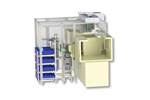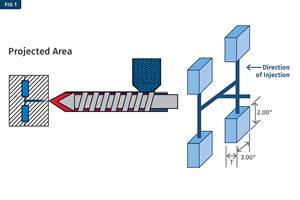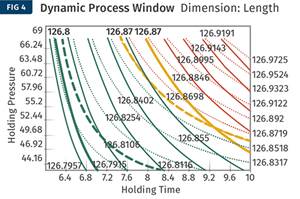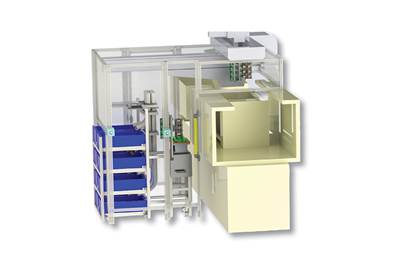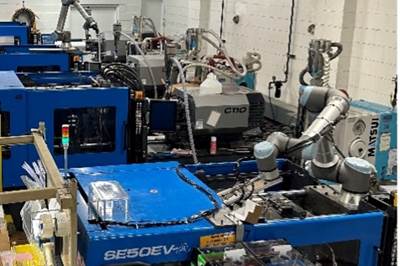Why Are Cobots Popping Up in Injection Molding Processes?
Collaborative robots (cobots) can play a vital role in broadening a plastics processor’s automation portfolio.

At Midgard, Operations Manager Wes Brown programs a cobot from Universal Robots using the hand-guiding method. Source (all images): Universal Robots
Collaborative robots (cobots) have seen widespread adoption across plastics production processes from tending injection molding machines to a variety of processing tasks (degating, trimming, polishing, etc.) to product inspection, packaging and palletizing. Like traditional automation, cobots help plastics processors address labor shortages, ensure consistency, raise throughput, reduce scrap and increase production rates.
What is it about cobots that’s driving plastics companies to deploy more of these robots on injection molding tasks?
Powerful Automation in a Compact Form
Real estate is at a premium in plastics processing facilities, especially during busy production runs. Traditional automation, like three-axis pickers, has a large footprint, is fixed in position and requires a cage. These factors hinder the cost justification for many companies that are looking for more flexible tools with a smaller footprint and less production downtime. Dexterous six-axis cobots can handle many secondary operations in between part extraction such as degating, drilling and other processing tasks. This means that not only can a cobot perform some tasks other robots can’t manage, but it also means that a cobot can work continuously in between part removal duties.
You can bring the cobot to the work versus bringing the work to the cobot.
Following a risk assessment, cobots can be deployed without fencing or guarding due to their built-in safety features. Not all cobots provide the same variety of safety features, online academy training or interfaces designed for injection molding, so be sure to focus on trusted cobot brands with an ecosystem of verified compatible injection molding software and peripherals.
Cobots also have a much smaller footprint than traditional automation. Despite coming in many sizes with a range of reach and payload capabilities, they support rapid deployment in fast-moving plastics processing facilities since they don’t have to be fixed and bolted into one position. You can bring the cobot to the work versus bringing the work to the cobot. You can wheel them around on a dolly. You can mount them on a press to keep it running in automatic mode. You can mount them on a seventh axis, on rails or on autonomous mobile robots. All of this means incredible flexibility for end users, along with streamlined redeployments on high-mix/low-volume production runs and faster return on investment. For simple injection molding applications, plastics processors typically see ROI on a cobot investment within 12 months.
Easy Interface Integration
Given the importance of smooth interfacing between your robots and your injection molding machine, it’s vital that your cobot understands protocols like EUROMAP 67. Look for brands that provide molding machine interface capabilities, which will help you control and break down every part of the molding sequence while your cobot arm is within the machine. Having a dedicated EUROMAP 67 interface will also enable easy control of the core pullers, air blow, and the time frames for opening/closing the machine and part ejection. Moreover, if you choose a cobot with an interface module, all the I/O functions of the robot will be automatically prepared by the cobot. This means that all end users will need to do is intuitively hand guide the cobot arm from waypoint to waypoint. In this sense, cobots are a radical departure from traditional automation counterparts.

Selecting a cobot with a EUROMAP 67 interface significantly simplifies the time and effort needed to integrate a cobot with the injection molding machine.
Some traditional automation can pose challenges and add costs due to programming. In some cases, technical experts, like integrators, need to be brought in when the robot requires programming or reprogramming.
Leading cobot brands enable relatively quick and easy programming regardless of the processor’s previous levels of automation exposure. Your internal teams can easily pick up how to use cobots, saving on integrator costs and reducing downtime during product and process changeovers.
Again, not all brands are the same when it comes to ease of programming, so look for cobots with features like hand-guiding and trusted, human-friendly interfaces.
Versatile Automation Delivers Extra Value
With the right software and peripherals, cobots can be used across multiple application domains, delivering value and ROI in multiple ways from advanced finishing to degating, with precision to a few thousands of an inch. Alternatively, a cobot could tend to a press for part of a shift and then be dedicated to finishing or inspection tasks on another shift.
About the Author: Christopher Buse, Novi, Michigan, has a background in automotive process engineering and medical device manufacturing. He began his career as a process engineer in 2017 and has worked alongside automation and robotics for just under a decade, implementing them into existing processes as well as new installs. He brought his experience in high-mix, low-volume manufacturing environments to Universal Robots in 2022 as an application engineer with a focus in plastics. In 2024, he was promoted to application engineering manager for the western half of the U.S. Contact: 844-GO-COBOT; chbu@universal-robots.com.

Here, a Universal Robots cobot mounted on a mobile platform is wheeled between cells at AIM Processing in Colorado by Jon Gelston, company president.
Related Content
Is There a More Accurate Means to Calculate Tonnage?
Molders have long used the projected area of the parts and runner to guesstimate how much tonnage is required to mold a part without flash, but there’s a more precise methodology.
Read MoreProcess Monitoring or Production Monitoring — Why Not Both?
Molders looking to both monitor an injection molding process effectively and manage production can definitely do both with tools available today, but the question is how best to tackle these twin challenges.
Read MoreUsing Data to Pinpoint Cosmetic Defect Causes in Injection Molded Parts
Taking a step back and identifying the root cause of a cosmetic flaw can help molders focus on what corrective actions need to be taken.
Read MoreOptimizing Pack & Hold Times for Hot-Runner & Valve-Gated Molds
Using scientific procedures will help you put an end to all that time-consuming trial and error. Part 1 of 2.
Read MoreRead Next
Choosing the Right Projects to Automate
What are the strategies and upfront work that go into identifying production problems that could benefit from an automation solution?
Read MoreInjection Molder Amplifies Automation for Optimized Production
AIM Processing has parlayed small part molding expertise and aggressive automation, even for short run production, into a highly successful custom molding ´óĎó´«Ă˝.
Read MoreDirect Communication, Control Between Cobots and IMMs
NPE2024: Universal Robot is showing how its Injection Molding Machine Interface (IMMI) module facilitates direct communication and control between its robots and molding machines.
Read More